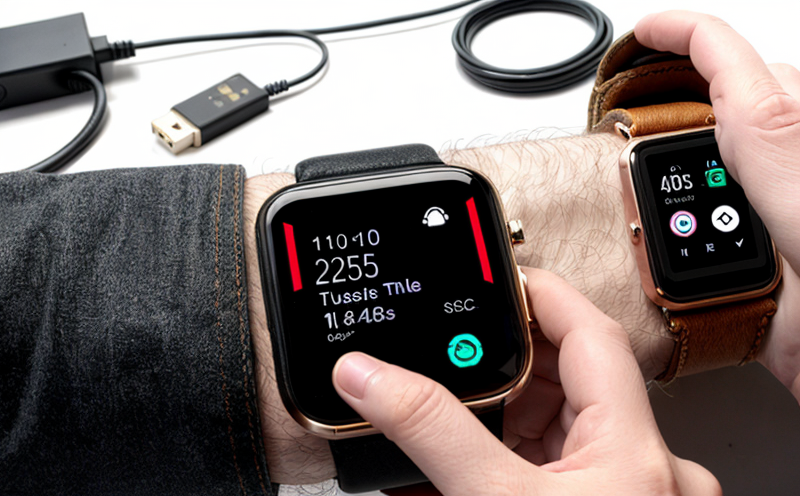ASTM E308 Color Quality Testing for Portable Displays
ASTM E308 Color Quality Testing for Portable Displays is a critical component in ensuring that electronic devices such as smartwatches, fitness trackers, and other portable gadgets meet the highest standards of visual quality. This method evaluates how accurately colors are reproduced on these displays by measuring their spectral reflectance or transmittance. The primary focus is to ensure that the color rendition is consistent across different viewing conditions and environments.
The ASTM E308 standard uses a CIE 1976 L*a*b* color space, which provides a more intuitive way of assessing color differences than traditional RGB or XYZ coordinates. This approach allows for precise measurement and comparison of colors under various illuminants (light sources), including daylight, incandescent light, and fluorescent lighting.
For portable displays, the challenge lies in maintaining consistent color quality over time due to factors like temperature changes, humidity variations, and mechanical stress during use. Our laboratory uses state-of-the-art spectrophotometers capable of capturing minute differences in color that may not be visible to the naked eye but can significantly impact user experience.
Our testing process begins with thorough preparation of the samples. For portable displays, this involves ensuring they are clean and undamaged before placing them into the measurement fixture of our spectrophotometer. Once prepared, we then proceed to measure color values according to ASTM E308 criteria under specified illuminants.
The results from these measurements provide detailed information about the accuracy with which colors are rendered on each device's screen. This includes not only hue but also saturation and brightness levels. These metrics help us identify any deviations from expected performance that could indicate issues in manufacturing or design.
By adhering strictly to ASTM E308 standards, we ensure our clients receive reliable data regarding color quality which is essential for maintaining brand reputation and customer satisfaction. It helps manufacturers make informed decisions about product improvements based on real-world usage conditions rather than theoretical specifications alone.
- Consistency: Ensures consistent color rendering across all units of a particular model.
- Accuracy: Measures exactness in the reproduction of colors as intended by designers.
- User Experience: Directly impacts how users perceive and interact with their devices.
In summary, ASTM E308 color quality testing plays a vital role in enhancing the overall user experience for wearable and portable electronics. By using this standard, manufacturers can ensure their products meet high-quality expectations while also complying with international regulations related to product safety and performance.
Benefits
The benefits of ASTM E308 color quality testing extend beyond just meeting regulatory requirements; it offers significant advantages for both manufacturers and consumers alike:
- Enhanced Brand Reputation: Consistent, high-quality color reproduction enhances the reputation of your brand in the market.
- Better Product Performance: Ensures that every unit produced meets the same stringent quality standards.
- Increased Consumer Satisfaction: Happy customers are more likely to recommend your products and return for future purchases.
- Competitive Advantage: Superior color accuracy can set your product apart from competitors in the market.
- Cost Efficiency: Identifying and addressing issues early in the production process reduces costs associated with rework or recalls later on.
In today's competitive landscape, delivering a superior user experience is key to success. By incorporating ASTM E308 color quality testing into your quality control processes, you can ensure that every device coming off your assembly line meets these exacting standards.
Customer Impact and Satisfaction
The impact of ASTM E308 color quality testing on customer satisfaction cannot be overstated. When users interact with a product, one of the first things they notice is its appearance—specifically how well colors are rendered on the display. If there are discrepancies between what was designed and what appears on screen, it can lead to frustration and dissatisfaction.
Our testing ensures that these differences are minimal if not non-existent. This leads directly to higher levels of customer satisfaction because users get exactly what they expect from their devices. Furthermore, consistent color quality across all units produced contributes significantly towards building trust among customers who rely on the accuracy of such displays for important tasks like health monitoring or navigation.
Moreover, satisfied customers are more likely to recommend your products positively which translates into increased sales and market share. This positive feedback loop strengthens relationships with existing customers while also attracting new ones seeking reliable performance from their wearable tech devices.
International Acceptance and Recognition
ASTM E308 color quality testing is widely recognized internationally as a robust method for evaluating the accuracy of colors on electronic displays. Its acceptance spans across various industries including consumer electronics, automotive, aerospace, and more.
The United States Department of Commerce’s National Institute of Standards and Technology (NIST) has endorsed ASTM E308, further cementing its status within regulatory frameworks worldwide. Many countries have adopted this standard as part of their national testing protocols for ensuring product compliance with international quality standards.
By adhering to ASTM E308 guidelines during production processes, manufacturers can confidently meet global market demands while avoiding potential pitfalls associated with non-compliance. This aligns perfectly with the goals set forth by organizations like International Electrotechnical Commission (IEC), which seeks harmonization of technical standards across borders.
International acceptance and recognition not only enhance credibility but also facilitate smoother trade between countries since there is less variability in how products are tested and approved.





